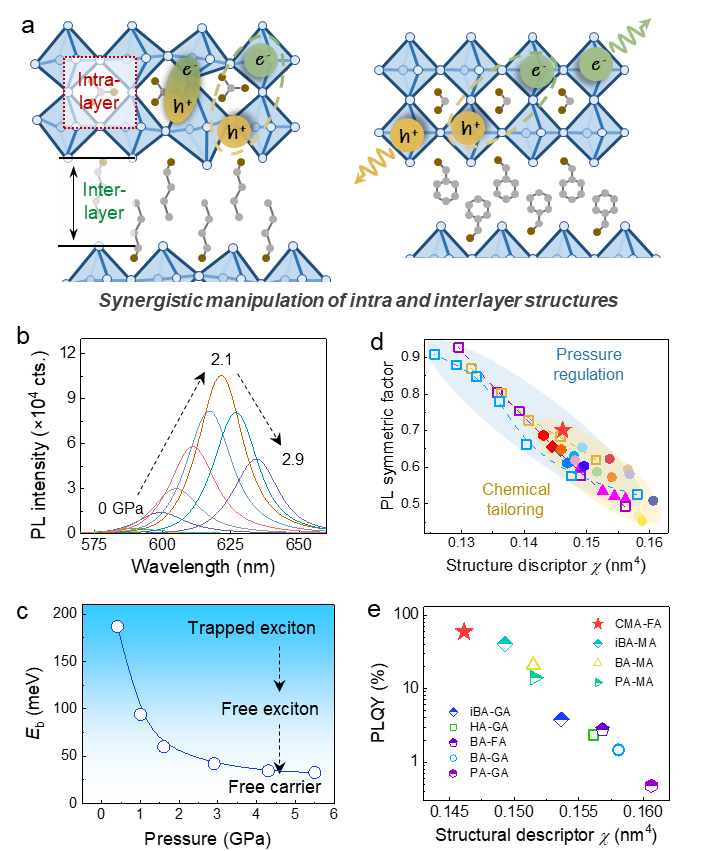Designing 2D halide perovskites for advanced optoelectronic applications necessitates a profound understanding of the structure-property relationships that influence their excitonic behaviors. Despite this, a comprehensive design framework that considers both intra and interlayer structures modified by A-site and spacer cations, respectively, remains undeveloped. A recent breakthrough study led by Dr. Xujie Lü from the Center for High Pressure Science and Technology Advanced Research (HPSTAR), in collaboration with Prof. Yongping Fu from Peking University and Prof. Song Jin from University of Wisconsin-Madison, has provided new insights into this area. Their research focuses on the synergistically tuning of intra and interlayer structure that result in improved optoelectronic performances. This pioneering research, titled "Exciton engineering of 2D Ruddlesden–Popper perovskites by synergistically tuning the intra and interlayer structures" has recently been published in Nature Communications.
By using pressure to tune the 2D perovskite structure, the researchers realize the controllable exciton engineering from equilibrium of trapped and free excitons to equilibrium of free excitons and carriers. The PL intensity of (BA)2(GA)Pb2I7 perovskite shows a 72-fold boost upon compression due to the suppression of exciton trapping, and the photoconductivity exhibits a 10-fold increase because of the decreased exciton binding energy. “We introduce a general structural descriptor, χ, which considers both intra and interlayer structural characteristics of 2D perovskites and quantitatively demonstrate that a decreasing χ correlates with a more symmetric PL and higher emission intensity.” said by Songhao Guo from HPSTAR. Guided by this principle, the team design a new 2D perovskite (CMA)2(FA)Pb2I7 featuring a smaller intralayer cation (FA) and a more compact interlayer cation (CMA) to mimic the pressure-induced structural changes. This (CMA)2(FA)Pb2I7 perovskite with a reduced χ exhibits an exceptionally high PLQY of 59.3%, setting a new record among known n = 2 RP perovskites.

Caption: (a) Illustrations of the synergistic manipulation of the intra and interlayer structures towards more desirable excitonic properties of 2D perovskites. (b) In situ steady-state PL spectra at selected pressures. (c) Calculated exciton binding energy Eb as a function of pressure. (d) Symmetric factor as a function of structural descriptor χ for various 2D RP perovskites under pressure regulation or with chemical tailoring. (e) The relation between the PLQY and structural descriptor χ for various common n = 2 2D perovskites (LA)2APb2I7 (abbreviated as LA-A).
These findings illustrate a universal strategy for engineering the excitonic properties of n > 1 perovskites through the synergistic tuning of intra and interlayer structures. The proposed structural descriptor, χ, offers a valuable tool for the rational design of high-performance 2D perovskites, paving the way for the development of efficient optoelectronic devices.
为了设计用于高性能光电应用的二维金属卤化物钙钛矿,深入了解其激子行为与结构-性能之间的关系至关重要。然而,要在n≥2的二维钙钛矿中获得最理想的激子特性,需要同时考虑层内和层间结构参数,以构建具有各向异性的层状结构。近日,北京高压科学研究中心(HPSTAR)吕旭杰研究员带领的研究团队,与北京大学傅永平教授和威斯康星麦迪逊大学的金松教授等团队合作,深入研究了二维钙钛矿中层内和层间结构的协同调控对激子特性和光电性能的重要影响。相关成果以“Exciton engineering of 2D Ruddlesden–Popper perovskites by synergistically tuning the intra and interlayer structures”为题,发表于近期的《自然 通讯》(Nature Communications)上。
